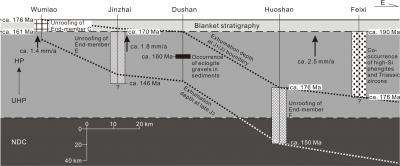How can basin rocks recorded formation of Dabie orogen?

Deep subduction of continental crust and rapid exhumation of ultrahigh-pressure metamorphic rocks, and its mechanism have been one of the most important issues of the world's attention in the Dabie orogen. Professor LIU Shaofeng from State Key Laboratory of Geological Processes and Mineral Resources, China University of Geosciences (Beijing) and his co-author set out to tackle this problem. Their study results fully demonstrated that basin sediments recorded Dabie formation process and supplied important trails for Dabie uplifting and exhumation. Their work, entitled "Mesozoic basin development and its indication of collisional orogeny in the Dabie orogen", was published in Chinese Science Bulletin 2013, 58.
Dabie orogen was formed by collision between the South China and North China plates. During and after collision periods, sedimentary basins were developed beside and within the mountains, in which the sediments sourced from Dabie were filled. These sedimentary strata, like "historical book", recorded the geological processes of subduction of the South China plate under the North China plate and then rapid uplift and unroofing of the subducted South China plate. Therefore, it is effective to probe into Dabie Mountains formation based on basin sedimentary stratigraphic analysis.
These newly studies have shown a fundamental progress. The Dabie orogen records gradual transition from overall shortening and thrusting to dominantly extension and rift basin formation expanded from its core to its margins, although these shortening and extension overlapped in time from the Jurassic through Early Cretaceous at crustal levels. The unroofing ages of the ultra-high pressure metamorphic rocks subducted into hundreds kilometers deep in the Dabie orogen change from Early Jurassic to Late Jurassic westward. The depth of exhumation increases eastwards (Fig. 1). The sediment sources for the basin in the north are mostly composed of the deeply exhumed, axial Dabie metamorphic complex, and the sediment sources for the basin in the south are mostly from cover strata in the southern orogen and related strata with subjacent (i.e. subsequently overthrusted) plate suture belt.
Geodynamic analysis represents that continental collision between the North China Block and the South China Block along the plate sutures, subsequently northwestward progradation of the Jiangnan fold and thrust belt, and the underthrusting of the North China Block along the Northern Boundary Fault of Qinling Range led to crustal thickening, gravitational spreading and balanced rebound of the resultant thick crustal welt, and multi-episodic exhumation of the HP/UHP metamorphic rocks.
This work will be a valued reference of probing into how sedimentary basins record tectonic evolution of the orogenic belt which underwent deep continental subduction, rapid exhumation, and the huge amount of erosion. Furthermore, it will be significant to reveal the evolution of basin/mountain system and geodynamics.
Journal information: Chinese Science Bulletin
Provided by Science China Press















